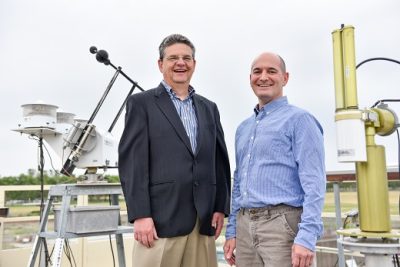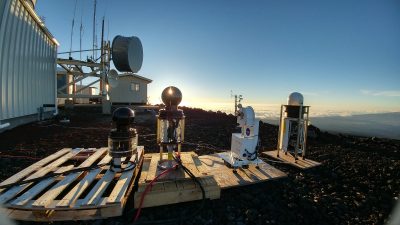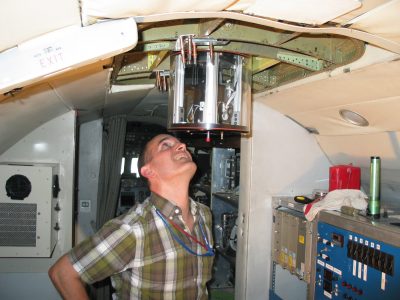ARM Facility Plays Early Role in Longtime Instrument Collaboration
Published: 16 August 2017

With a little help from the ARM Facility, an instrument development collaboration between scientists at Pacific Northwest National Laboratory (PNNL) and NASA got off the ground about a decade ago. The project continues to bear fruit today.
ARM Aerial Facility (AAF) Manager Beat Schmid and fellow PNNL atmospheric scientist Connor Flynn, an ARM aerosol translator, participated in the joint effort to build a unique instrument that collects sun and sky light. That work initially resulted in 4STAR—Spectrometer for Sky-Scanning, Sun-Tracking Atmospheric Research. The venture has led to participation in a half-dozen airborne field campaigns—the first being the ARM Two-Column Aerosol Project (TCAP)—and the production of several related instruments. They include ground-based 2STAR and 3STAR, and the newest airborne addition, 4STARB.
Researchers are using 4STAR and its successors—all part of the nSTAR instrument family—to better understand the interplay of sun energy, tiny atmospheric particles, clouds, and gases that influence earth system processes. Light is absorbed or scattered by the atmospheric particles, or it reaches the Earth. Measuring the amount of direct light that gets through the clouds, particles, and gases can help researchers figure out the amount of each atmospheric component. When atmospheric particles scatter light at different angles, scientists can determine particle size, shape, and ability to absorb energy.
In August 2017, 4STAR will participate in the ongoing NASA ORACLES (ObseRvations of Aerosols above CLouds and their intEractionS) study. ORACLES overlaps with the ARM field campaign LASIC (Layered Atlantic Smoke Interactions with Clouds) at Ascension Island. Meanwhile, 4STARB will fly its maiden voyage on the NASA C-130 as part of NAAMES (the North Atlantic Aerosols and Marine Ecosystems Study).
Schmid worked on the early 4STAR concept with scientists at the NASA Ames Research Center, 40 miles south of San Francisco, before he joined PNNL in 2006. Schmid and his colleagues started the research to build 4STAR in 2003, aiming to roll ground- and air-based capabilities of existing instruments into one apparatus. For instance, from the ground, the Cimel sunphotometer could measure scattered light, as well as collect direct solar beam data to help determine how much light was missing or getting absorbed. Meanwhile, NASA Ames was able to measure the direct beam, requiring accurate tracking of the sun, on a moving airplane with the Ames Airborne Tracking Sunphotometers (AATS-6 and AATS-14—the numbers denote the amount of discrete wavelengths).
“The team’s idea was to combine the two things—the direct beam and the scattered light—do it from an aircraft and fully spectral,” says Schmid, who continued to work on the project after coming to PNNL. “That was the dream.”

Just as the instruments have evolved over time, the science gleaned from them also is taking shape.
“Some parts of atmospheric science are more in the realm of discovery, which is still a critical element of science,” Flynn says. “In a lot of ways, that’s where we are with understanding the interactions between clouds and aerosols, and the effect that has on cloud regimes.”
Researchers are filling in knowledge gaps with the help of 4STAR and related instruments. Of ORACLES, which seeks to help improve global models by studying cloud-aerosol-radiation interactions off the southwest African coast, Flynn says: “We’re literally flying through those layers, mapping where the aerosols are, where the clouds are, measuring properties, and we are finding out things that nobody knew. Nobody knew how often the aerosol is in contact with the cloud, how often it’s above it, and what the properties of the aerosols are.”
Evolution of 4STAR
Looking at the top piece of 4STAR, you might mistake it for a bowling ball, but it’s actually an optical collector that is installed through the upper hull of an aircraft. During flight, it mines the sun and sky light for information on clouds, atmospheric particles, and various trace gases. The light is sent through a fiber optic cable to temperature- and humidity-controlled light-measuring equipment on the aircraft.
Schmid, Flynn, and a group of researchers from NASA Ames are among those who have helped the instrument become what it is. Flynn came onboard in 2007 to help fine-tune 4STAR’s sky-scanning capabilities and clean up processing code.
“I managed to speed that up enough to make airborne operation feasible, so I was in the 4STAR group at that point,” Flynn says.

After the team constructed a ground prototype (4STARG), the next step was an airborne version. Enter the AAF, which in 2008 co-sponsored a workshop that discussed airborne instrumentation advances in atmospheric research. The AAF then issued a call for proposals that would address needs in that area. Flynn submitted a competitive proposal, and it was one of five efforts to be awarded support, helping the team eventually produce a hardened 4STAR for aircraft use. Test flights took place on the Gulfstream-1 aircraft, which PNNL operates for the U.S. Department of Energy.
In the summer of 2012, 4STAR first saw the light of day for a field campaign—TCAP, along the Massachusetts coast. The campaign sought to investigate how atmospheric particles interacted with sunlight and clouds during the summer and winter, and in different weather conditions. Researchers sampled a column of air over the Cape Cod National Seashore and one above the Atlantic Ocean, about 155 miles off the coast. Installed on the G-1, 4STAR collected measurements of aerosol optical depth and columnar water vapor during intensive operational periods in July 2012 and February 2013.
“The strengths were the mechanical design,” Schmid says. “It operated almost flawlessly.”
Since that initial field campaign, Flynn has supported 4STAR operation in SEAC4RS 2013 (Studies of Emissions and Atmospheric Composition, Clouds, and Climate Coupling by Regional Surveys) mostly over the Southeastern United States and Gulf of Mexico, ARISE 2014 (Arctic Radiation – IceBridge Sea and Ice Experiment) over the Arctic Ocean, KORUS-AQ 2016 (Korea United States Air Quality) over South Korea and the surrounding waters, and ORACLES 2016 off the coast of South Africa.
Schmid and Flynn received a NASA Group Achievement Award in 2011 for being part of the 4STAR Development Team. They won the award again in 2015 as part of the SEAC4RS campaign, during which 4STAR flew on NASA’s DC-8 in the summer of 2013.
4STARB and Beyond
Schmid was less hands-on with the development of 4STARB, but he provided invaluable feedback and technical guidance.
“I kept hammering the need for accurate calibration,” he says.
With 4STARB, the team eliminated a fiber optics rotating coupler that affected the instrument’s stability. In its place is a fiber optics clockspring that winds and unwinds, “so it promises the potential of better calibration and repeatability,” Flynn says. “We’ve modified our technology and approaches to fiber optics quite a bit through this process. We learned a lot about transmitting light through fiber optics. Everybody thinks it’s easy, but it’s not easy to do at the 99 percent calibration level we strive for.”
The new instrument is built sturdier to withstand flight conditions and features upgrades for improved measurements of direct solar beam transmission, sky and zenith (upward) radiance, and hyperspectral absorption (for trace gas retrievals). Software updates also make for easier in-air operation.
Next up, the team is preparing for NAAMES, a five-year study that examines how ocean system processes influence clouds, atmospheric particles, and earth system processes.
Future additions to the nSTAR instrument family are being discussed. A proposed 5STAR configuration would include an imager for sun tracking, cloud detection, and scene classification.
“If this continues working,” Schmid says, “NASA will use this for a decade or more.”
Although the ARM Facility last used 4STAR during TCAP, Schmid says, “I hope that someone will propose it for a future ARM campaign again.”
The ARM Climate Research Facility is a DOE Office of Science user facility. The ARM Facility is operated by nine DOE national laboratories, including Pacific Northwest National Laboratory.
Keep up with the Atmospheric Observer
Updates on ARM news, events, and opportunities delivered to your inbox
ARM User Profile
ARM welcomes users from all institutions and nations. A free ARM user account is needed to access ARM data.


















